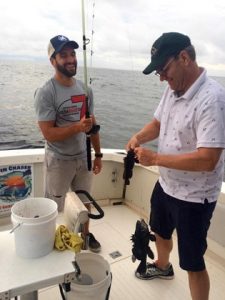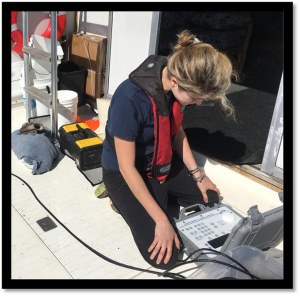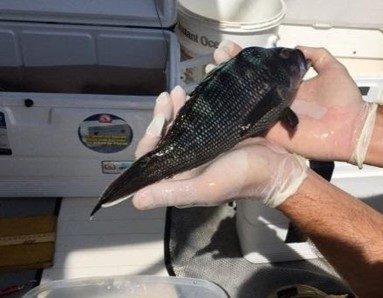State Spotlight: Maryland
Dr. Dave Secor, University of Maryland Center for Environmental Science
Black sea bass are the single most landed recreational fish caught in Maryland’s nearshore waters, including at wreck and artificial reef sites within and near the Maryland Wind Energy Area (WEA). Professor David Secor and his students at the University of Maryland Center for Environmental Science electronically tagged black sea bass during the summers of 2016-2019 to evaluate baseline movement behaviors and condition in advance of offshore wind development. This work was supported through Maryland’s Offshore Wind Development Fund to help address key information gaps on important fishery resources. Here is what they discovered:
Stormy Seas: During summer and fall large storms, including hurricanes, occurred every year causing catastrophic changes to the bottom waters black sea bass inhabit. Winds mixed warm surface waters causing bottom water temperatures to rise 8 to 14 °C in the span of hours. Bottom temperatures recovered after early storms but the water column became completely mixed (destruction of the “cold pool”) by early September each year, always associated with the passage of a major tropical storm.
Evacuations: Just like human populations, individual black sea bass either evacuated or hunkered down in response to storms. During summer months, black sea bass exhibited strong site fidelity to wreck sites, but when large late summer storms hit, sudden departures followed. Those individuals that remained showed reduced activity levels.
Not a well behaved “demersal” species: During the day, black sea bass ascend half the distance to the surface and persist there before hunkering down in structure each night. That this demersal species is so pelagic is a new discovery and is likely key to their spawning and feeding success.

Fishing for black sea bass on F/V Fin Chaser (Mike O’Brien and Dave Secor) Credit: UMCES
But… still a good model species: Because they are ubiquitous within the MD WEA and other Mid-Atlantic and southern New England WEAs, black sea bass are a model species for wind energy impacts. Although black sea bass show extensive vertical movements, they maintain themselves in narrow home ranges focused on wreck structures. Diminished vertical activity could be a key indicator of wind energy construction and operation impacts. Their site fidelity to wreck sites make them ideal candidates for Before After Control Impact and Before After Gradient studies associated with offshore wind turbine construction and maintenance effects, as well as the so-called reef effect.

Graduate student C. Wiernicki calling up a telemetry receiver through a sea surface transponder and deck box. Credit: UMCES
For more information:
Secor, D.H., F. Zhang, M. O’Brien, and M. Li. 2019. Ocean destratification and fish evacuation caused by a Mid-Atlantic Tropical Storm. ICES Journal of Marine Science 76:573-584.
Wiernicki, C. M.O. Brien, F. Zhang, V. Lyubchich, M. Li and D. Secor. 2020. The recurring role of storm disturbance on black sea bass (Centropristis striata) movement behaviors in the Mid-Atlantic Bight. Plos One.
Share this:

Black sea bass
Credit: UMCES






